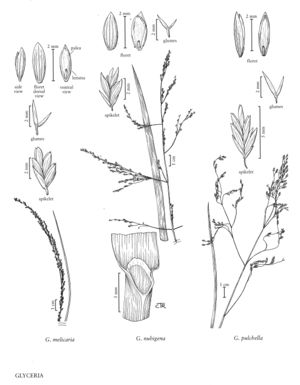Glyceria nubigena
Plants perennial. Culms 100-200 cm tall, 3-5 mm thick, smooth. Sheaths smooth or scabridulous, weakly keeled; ligules 1-1.5 mm, truncate; blades to 45 cm long, 6-10 mm wide, abaxial surfaces smooth or scabrous, adaxial surfaces scabrous. Panicles 20-30 cm long, 7.5-14 cm wide, open, pyramidal; branches 7.5-14 cm, spreading or reflexed, lax, with 16-80 spikelets; pedicels 2-7 mm. Spikelets 3.5-5.5 mm long, 2-3 (3.5) mm wide, laterally compressed, oval in side view, with 3-5 florets. Glumes tapering from below midlength to the narrowly (less than 45°) acute apices, veins not extending to the apices; lower glumes 0.8-1.5 mm; upper glumes 1.8-2.2 mm; rachilla internodes about 0.5 mm; lemmas 2.2-2.7 mm, 0.9-1.1 mm wide in dorsal view, veins distinctly raised, usually smooth over and between the veins, sometimes scabridulous over the veins, apices acute, prow-shaped; paleas slightly shorter than the lemmas, lengths 2-2.7 times widths, keels not winged, tips incurved, apices narrowly notched between the keels; anthers 2, about 1.5 mm, dehiscent at maturity. Caryopses about 1.5 mm. 2n = 40.
Discussion
Glyceria nubigena is known only from moist areas of balds and high ridges in the Great Smoky Mountains of North Carolina and Tennessee.
Selected References
None.
Lower Taxa
"decumbent" is not a number.
